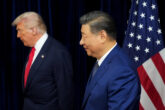September 12, 2018
Quantum Hegemony?
China’s Ambitions and the Challenge to U.S. Innovation Leadership
Executive Summary
China is positioning itself as a powerhouse in quantum science. Within the past several years, Chinese researchers have achieved a track record of consistent advances in basic research and in the development of quantum technologies, including quantum cryptography, communications, and computing, as well as reports of progress in quantum radar, sensing, imaging, metrology, and navigation. Their breakthroughs demonstrate the successes of a long-term research agenda that has dedicated extensive funding to this domain while actively cultivating top talent. China’s rise as a powerhouse in quantum science was displayed to the world with the August 2016 launch of the world’s first quantum satellite, Micius (or Mozi, 墨子). Since then, China’s launch of new national “megaprojects” in quantum communications and computing reflect the continued prioritization of these technologies.
China’s leaders recognize the strategic potential of quantum science and technology to enhance economic and military dimensions of national power.
At the highest levels, China’s leaders recognize the strategic potential of quantum science and technology to enhance economic and military dimensions of national power. These quantum ambitions are intertwined with China’s national strategic objective to become a science and technology superpower (科技强国). Rather than relying primarily on the “absorption” of foreign technologies in its pursuit of indigenous innovation, China instead intends to achieve truly disruptive, even “radical” innovation (源头创新) in strategic emerging technologies, including biotechnology and artificial intelligence. As China advances a national strategy for military-civil fusion (or “civil-military integration,” 军民融合), these critical technologies also will be leveraged for a range of defense applications. While international collaborations can be integral to advancing global scientific progress, the sensitivity and strategic objectives associated with these technologies in China could, at worst, undermine such engagements, perhaps resulting in such future “made in China” innovation being restricted to China.
China clearly aspires to lead the “second quantum revolution” that is occurring with the advent of these new technologies. China’s widespread employment of provably secure quantum cryptography and quantum communications is intended to create new networks that will be, at least in theory, “unhackable.” In the decades to come, the realization of quantum computing will create unparalleled computing capabilities, with impactful applications that include cracking prevalent types of encryption. Although China is a relative latecomer to the race, this competition will be a marathon, not a sprint, taking place over decades to come, and Chinese scientists – who are receiving nearly unlimited resources and recently have established a new world record for entangled quantum bits (qubits) – could catch up in the long term. Meanwhile, Chinese researchers claim to have achieved notable advances in quantum radar, sensing, imaging, metrology, and navigation, which enable greater precision and sensitivity. In addition, early research in quantum materials, such as topological insulators, may enable new paradigms of information processing, have applications in clean energy, and even be used in one pathway to quantum computing.
China’s advances in quantum science could impact the future military and strategic balance, perhaps even leapfrogging traditional U.S. military-technological advantages. Although it is difficult to predict the trajectories and timeframes for their realization, these dual-use quantum technologies could “offset” key pillars of U.S. military power, potentially undermining critical technological advantages associated with today’s information-centric ways of war, epitomized by the U.S. model. As China shifts its most sensitive military, governmental, and commercial communications to quantum networks, this transition could enhance information security, perhaps frustrating U.S. cyber espionage and signals intelligence capabilities, though these systems will likely remain susceptible to exploitation nonetheless. At the same time, this national transition to quantum cryptography could ensure that China will be more secure against the more distant threat that a future quantum computer might be able to break prevalent kinds of cryptography using Shor’s algorithm. By contrast, the United States has yet to progress toward implementing such solutions, or alternatives from post-quantum cryptography, at scale. Going forward, if China succeeds in becoming a pioneer in quantum computing, then the leveraging of such immense computing capabilities could convey strategic advantage, placing sensitive information systems at risk. Meanwhile, the introduction of quantum navigation may allow greater independence from space-based systems, and the realization of quantum radar, imaging, and sensing would enhance domain awareness and targeting, potentially undermining U.S. investments in stealth technologies or even allowing for the tracking of submarines. In the aggregate, these advances could support the continued emergence of the Chinese People’s Liberation Army (PLA) as a true peer competitor in these new technological frontiers of military power.
China’s advances in quantum science could impact the future military and strategic balance, perhaps even leapfrogging traditional U.S. military-technological advantages.
The United States must recognize the trajectory of China’s advances in these technologies and the promise of their potential military and commercial applications. In response, the United States should build upon and redouble existing efforts to remain a leader, or at least a major contender, in the development of quantum technologies through enhancing the vitality of its innovation ecosystem. The United States must ensure that basic and applied research and development in quantum science and technology receive adequate, sustained funding, while seeking to attract and retain top talent. In the process, the exploration of new paradigms for public-private partnership will also be critical. While continuing to explore options for post-quantum encryption, the U.S. government should start to evaluate the costs and timeframes associated with a military- and government-wide transition from today’s prevalent forms of encryption to a new regime, which might require considerable changes to the underlying information infrastructure. The Department of Defense (DoD) also should undertake further analysis of the utility of available forms of quantum cryptography and communications to secure military information systems. As developments in quantum radar, sensing, imaging, metrology, and navigation become more mature, the DoD also should consider further prototyping of and experimentation with these technologies. Going forward, although the full impact of this second quantum revolution remains to be seen – and some skepticism is warranted – the United States must mitigate the long-term risks of technological surprise in this domain through leveraging its existing advantages in innovation.
The full report is available online.
More from CNAS
-
Transatlantic Security / Technology & National Security
Look Before We Leap on Artificial IntelligenceThis article was originally published on The Dispatch. A debate about the role that artificial intelligence should and will play in society, and how it will affect humanity fo...
By Jon B. Wolfsthal
-
Technology & National Security
Caleb Withers on the Cybersecurity Frontier in the Age of AICaleb Withers, research associate at the Center for a New American Security, joins Kevin Frazier, the AI Innovation and Law Fellow at the University of Texas School of Law and...
By Caleb Withers
-
Technology & National Security
Prepared, Not ParalyzedExecutive Summary The Trump administration has embraced a pro-innovation approach to artificial intelligence (AI) policy. Its AI Action Plan, released July 2025, underscores t...
By Janet Egan, Spencer Michaels & Caleb Withers
-
Indo-Pacific Security / Technology & National Security
Sharper: Tech + ChinaRecent talks between President Donald Trump and Chinese Communist Party General Secretary Xi Jinping placed a spotlight on emerging technologies, from high-end chips to minera...
By Charles Horn & Sevi Silvia






